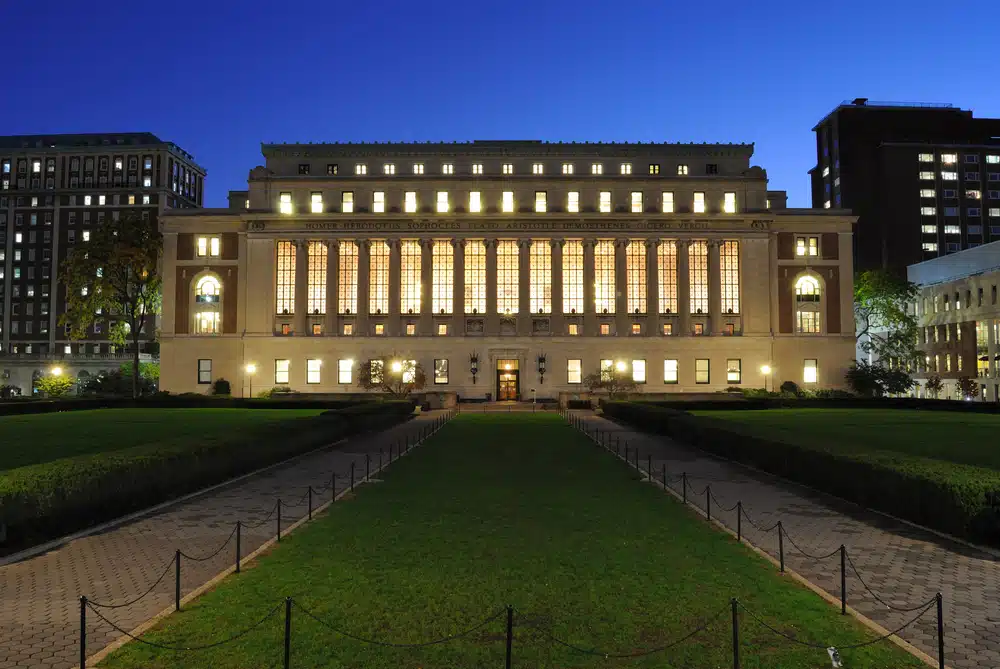How to transfer to Columbia
While the vast majority of undergraduate students who study at the prestigious and competitive Columbia University begin their education at the school as first-year students, there are students that are able to transfer into the school in the middle of their undergraduate education.
Of course, we are talking about transfer students. And while you may think that transferring from one undergraduate program to another is rare, it is actually far more common than you think. In fact, it is believed that somewhere between 15 percent and 40 percent of undergrad students will transfer during their education. Moreover, upwards of 2 million undergrad students transferred during the 2020-21 school year.
Whether attending Columbia University was always your goal and you are interested in joining the school’s student body as a transfer student, or if you are simply interested in learning more about the transfer process in the United States, then we have you covered! At AdmissionSight, we help both high schoolers and students that are already studying at college make their Ivy League dreams a reality.
For that reason, we thought that it would be really helpful to break down some of the most important facts, tips and considerations when it comes to transferring to Columbia. After all, just because you weren’t able to make the cut right after high school does not mean that you are not Ivy League material.
Sometimes, all it takes is a little bit of time and a little bit of impressive success at the collegiate level to convince the admissions committees at these highly selective schools that you belong! So, if you are interested in learning about how to transfer to Columbia and how to get into Columbia as a transfer student, then you have absolutely come to the right place!
Let’s get started.
Columbia transfer students
One thing that is really important for any student who is interested in applying to Columbia – or any top school for that matter – as a transfer student should know is that it can actually be quite a lot harder to apply to these kinds of schools as a transfer compared to applying as a first-year student.
Despite the fact that transfer applicants face a much smaller applicant pool, meaning they are competing with fewer students, the school’s admission committee expects that much more of transfer applicants. With that being said, it is not impossible by any means. As the school itself makes it quite clear on their official site:
“We’re intentional in our efforts to welcome over 100 transfer students each year, from a range of two- and four-year institutions, and we value the unique and diverse perspectives they bring to our community.”
Primarily, Columbia is interested in allowing students to transfer into the undergraduate program who will offer a unique perspective that can add to the cultural or educational diversity of the school.
This can mean a lot of things, but the important thing to keep in mind is that if you want to improve your chances of transferring into Columbia or a similarly selective school, you are going to have to really be sure that you can stand out both inside and outside of the classroom. When it comes to the application process, the school approaches the entire process in the same holistic manner that they approach the process for first-year students.
Columbia reviews specific applicants’ past achievements, potential and ability to contribute to the community at the school. Of course, there is a strong expectation that any student who applies to Columbia as a transfer and gets in will be able to thrive in the school’s rigorous and exceptional school curriculum.
But that is enough for a general overview. When it comes to learning how to transfer to Columbia, a lot of the most important information has to do with the specifics of deadlines, eligibility, what the school looks for in transfer applicants and more. So, like, get into it.
Columbia transfer requirements
When it comes to what is strictly required of students who are planning on a Columbia University transfer, there are three primary components that you have to be aware of. The first one is eligibility, the second are the required documents that the admissions committee will need to see in order to fully evaluate your application and the third one are the dates and deadlines that you will need to be aware of to make sure that you are getting your application and supplemental material submitted on time.
Columbia University transfer eligibility
To be eligible for enrollment as a transfer student at Columbia, you must have earned:
- 24 points of credit (the equivalent of one year of full-time study) at another institution, or be registered to complete 24 points of credit by the time you enroll.
- A high school diploma or equivalent (by the application deadline). If you left high school without receiving a diploma in order to attend an early college program, you are not eligible for transfer admission and must apply as a first-year student by the appropriate Early Decision or Regular Decision deadline. You will not be eligible to receive credit for such accelerated programs except for credit earned through standardized examinations (e.g., AP and IB exams); such credit will be limited to 16 points, the equivalent of one full semester at Columbia.
If you’re an International student, you should read our International Transfer Students section for additional eligibility requirements.
Candidates who have completed more than four semesters of college coursework elsewhere are not encouraged to apply. Columbia’s academic requirements and institutional policies make completion of all graduation requirements in a reasonable and timely fashion unlikely.
Columbia University transfer application requirements
- The Coalition Application
- Additional Columbia-specific questions
- $85 application fee or fee waiver request
- An official high school transcript from all high schools attended
- An official college transcript from all colleges attended
- The Coalition Application Transfer Report
- The Coalition Application Curriculum Report
- Standardized tests are not required during the 2021-2022, 2022-2023 or 2023-2024 application cycles.
- Applicants may choose to self-report their scores.
- Please see our standardized testing policy for details.
- Two College Academic Recommendations
It is important to note that for transfer students, the Coalition Application is required, as the Common Application is only available for first-year Columbia grads. However, there are some aspects of the Coalition Application that are required for Columbia transfer applicants and some components that are not required. Take a look at that list, below:
The following Profile sections are required for a complete transfer application to Columbia:
- Personal Information
- Contact Information
- Demographic Information
- Citizenship Information
- Family Information
- High School Information
- College Information
- College Coursework
- SAT/ACT
- Additional Tests
- English Proficiency Tests
- Fee Waiver
- Honors & Distinctions
- Academic Interests
- Activities/Experience- In the Activities/Experience section, please include details about activities from both high school and college. Be sure to include all clubs, organizations, research positions, jobs, internships and/or volunteer activities that you participated in beyond the classroom.
You are also welcome to upload a resume detailing your high school and college extracurricular activities in the “Uploads” section of the application.
The following Profile sections are not required for a complete transfer application to Columbia:
- 9th-11th Grade Coursework
- 12th Grade Coursework
- Coalition Essay
The school encourages transfer applicants to list all college coursework on their application, including current coursework, but discourages students from listing high school coursework.
While transfer applicants do not have to complete the Coalition Essay, they are expected to answer the following question in a 400 to 600 word essay response.
“Please explain why you are interested in transferring from your current institution. (The personal essay does not need to be specific to Columbia, but it should inform the committee why you wish to leave your current institution.)”
Columbia University transfer application dates and deadlines
Finally, here are the dates and deadlines that transfer applicants must be aware of.
- March 1: Application deadline for transfer candidates
- March 1: Financial aid application deadline
- By June 1: Admissions and financial aid decisions released online
- Mid June: Deposit deadline for admitted transfer students
- Late June: Deadline for final transcripts for admitted students.
What Columbia looks for in transfer applicants
As any student that has applied to Columbia very well knows, admission to this incredible school is not based on a simple formula of grades and test scores. Instead, the school looks at a variety of factors for each student. It goes without saying, but it is very important to know that because the room in both the sophomore and junior classes at Columbia are quite limited, admissions is incredibly competitive.
So, while transfer applicants are competing with far fewer applicants compared to first-year applicants, they are also competing for way less spots. From year to year, Columbia is known to accept fewer than 10 percent of transfer applicants each year.
With that in mind, considering the fact that acceptance rate for first-year students for the graduating class of 2026 was just 3.73 percent, an argument could be made that transfer students have – at the very least – a statistical advantage compared to first-year applicants.
Potential applicants are expected to have at least a 3.5 grade point average at their previous university or college and Columbia Engineering candidates are strongly encouraged to have a minimum of 3.5 GPA in their mathematics and sciences classes.
It is also important to know that all students who are admitted to Columbia as transfer students are expected and required to complete the school’s famous Core Curriculum requirements in addition to graduation requirements within their primary field of study to graduate. Because of that, the school’s admissions committee takes into account a candidate’s ability to complete their course of study in a standard timeline of eight total semesters.
To allow more flexibility with course selection at Columbia, the school recommends applying with first-year standing at your current institution when possible.
It is also important to note that because of the timing of the transfer application process, Columbia is generally unable to consider grades earned in the second semester of the year of application; thus, high school grades, rigor of program and standardized test scores are all important in the evaluation of transfer credentials, especially for students applying for sophomore standing.
If you have applied to Columbia previously, the documents you provided at that time will not roll over (with the exception of SAT or ACT scores); you must resubmit any information requested by this transfer application.
Columbia transfer applicant frequently asked questions
When it comes to learning how to transfer to Columbia, one of the best tools that students can take advantage of is information. Knowing what the school expects out of applicants and knowing how to set yourself apart from the rest of the transfer applicants that year is a great way to give yourself a natural leg up.
For that reason, AdmissionSight thought it would be useful to go over the most frequently asked questions that students who want to transfer to Columbia have asked over the years.
Are the SAT or ACT required for transfer applicants?
For many years, the SAT and ACT served very important functions for transfer applicants and first-year applicants at schools all over the country. However, in recent years, that trend has changed dramatically.
Several schools had already adopted a test-optional policy prior to the COVID-19 pandemic, but the pandemic and subsequent shutdowns all over the United States and world dramatically expedited the transition.
Right now, Columbia is a test optional. That includes transfer applicants. However, there are some definite benefits applicants can get from sending in an SAT or ACT score, namely a high score simply gives the admissions committee greater confidence that you would succeed at the school were you to enroll.
Can transfer students take part in the application interview process?
For some applicants, the interview process can offer a fantastic opportunity to allow the school to learn more about who the applicant is as a person. It’s another way for an applicant to stand out and let the school know about who they are as a person and not just a student.
It is not the school’s policy to interview transfer applicants. For that reason, students need to make sure to use the application as the appropriate platform to discuss everything they need to discuss that they feel is important and pertinent to their application at Columbia.
Are there scholarship options for Columbia transfers?
While you can transfer to Columbia, you should not even really consider doing so if you are going to look for athletic or talent-based institutional scholarships. The reason for that is because all of the financial aid at Columbia, for both first-year and transfer students is entirely need-based.
With that being said, students can absolutely seek out merit-based scholarships from organizations that are not connected to Columbia University, such as state grants and scholarships and local or national merit-based awards.
Can you transfer to Columbia from a community college?
If you are currently studying at a community college, or plan to start at the onset of the next semester, you may be wondering how to transfer to Columbia from a community college. In fact, you may be wondering if it is even possible to apply to Brown as a transfer student from a community college.
Well, the short answer is absolutely yes! In fact, several hundred students have transferred from community colleges to Ivy League schools in just the last few years alone.
But what is the reason for this, and is there anything that we can take from what community college transfers might offer Ivy League schools compared to transfer applicants from prestigious private schools or impressive public schools?
There are some simple, yet really important considerations to keep in mind. If you are wondering can you transfer from community college to Community, take a look at these considerations below:
- Community college students offer something new and can offer much needed cultural, background and experiential diversity to Ivy League classrooms.
- Success at community college has been proven to help predict success at Ivy League schools.
- There is a clear and defined academic need for students to transfer from community colleges to an Ivy League school compared to students who are transferring from other four-year colleges or universities.
Get more help in coordinating your Columbia University transfer
Columbia University is one of the most prestigious and competitive schools in the United States and getting in either as a first-year student or as a transfer is an incredible accomplishment.
It may seem like an impossible task, but it certainly is possible! If you are looking for ways to improve your chances of getting into Columbia as either a first-year or transfer applicant, contact AdmissionSight today to schedule a free consultation.









































